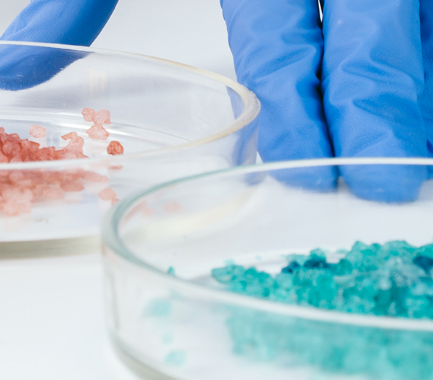Your contact
PENPET-Team - Hamburg

Tim Meister
Sales
Tel. +49 (0) 40 - 675 7 99 40
sales@penpet.de
Get in touch with us.
1,4-Cyclohexanedimethanol (CHDM)
1,4-cyclohexanedimethanol (CHDM) is a chemical industry base material from the group of dihydric alcohols, which is usually produced by a two-stage hydrogenation of dimethyl terephthalate. This creates two variants of the substance, the cis isomer and the trans isomer, the proportions of which differ depending on the catalyst used. Because of its low melting point, 1,4-cyclohexanedimethanol can exist as a solid, melt or liquid. It can be stored as a solid at temperatures below 30°C.
The compound is mainly used in the manufacture of polyurethanes and polyesters. It is used in the production of polyester fibers, polyurethane foam and synthetic resins, as well as lubricants, hydraulic fluids, coatings and cosmetics. Thermoplastics containing 1,4-cyclohexanedimethanol exhibit increased clarity, strength and solvent resistance. The substance is one of the most important starting materials for the production of polyethylene terephthalate (PET), which is known as the material for plastic bottles.
Let PENPET become your reliable supplier for 1,4-cyclohexanedimethanol (CHDM). We look forward to receiving your inquiry for an individual offer. Delivered either in iso tank containers or in 200 kg drums.
CAS no. 105-08-8
EINECS no. 203-268-9
Molecular formula: C8H16O2
Synonyms: CHDM, Cyclohex-1,4-diyldimethanol, Cyclohex-1,4-ylenedimethanol, 1,4-dimethylolcyclohexane, 1,4-bis(hydroxymethyl)cyclohexane, cyclohexane dimethanol
Application examples: Production of polyesters and polyurethanes
More Information
1,4-cyclohexanedimethanol (CHDM) belongs to the class of dihydric alcohols. These so-called diols have two alcoholic hydroxy groups, which are suitable for the construction of further compounds in the course of chemical reactions. The hydroxy groups of 1,4-cyclohexanedimethanol (CHDM) are located at the two ends of the symmetrically structured molecule, so that the substance can form extremely regular and linear structures during polymerization together with dicarboxylic acids, which similarly have two carboxy groups.
1,4-cyclohexanedimethanol exists in two isomeric variants. The molecules of cis- and trans-1,4-cyclohexanedimethanol basically have the same structure, but differ in the spatial arrangement of the two hydroxy groups. This results in slightly different chemical properties of the isomers. In terms of quantity, the cis isomer predominates in the customary methods of preparing 1,4-cyclohexanedimethanol.
At room temperature, 1,4-cyclohexanedimethanol (CHDM) is a waxy, white solid that develops more and more into a paste and finally into a viscous melt at higher temperatures. Beyond the melting range, the compound is a clear and colorless liquid. 1,4-cyclohexanedimethanol has a mild, sweet odor and is readily soluble in water and organic solvents such as ethanol, benzene, ketones and glycol ethers.
1,4-cyclohexanedimethanol (CHDM) is a stable and not very reactive compound that exists as a solid or paste at room temperature. The substance is combustible, but difficult to ignite. With the use of catalysts, 1,4-cyclohexanedimethanol can form long-chain esters with various dicarboxylic acids. This polycondensation process is the basis for the production of polyesters.
There is a risk of severe eye irritation when handling 1,4-cyclohexanedimethanol (CHDM). Wearing eye protection is therefore required. In case of contact, the eye should be gently flushed with water for several minutes to prevent serious eye damage. Since 1,4-cyclohexanedimethanol (CHDM) is classified as hazardous to water, the substance should not be released into the environment.
